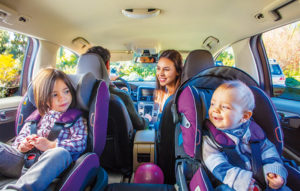Rear Facing – the Way Forward!

As a parent or caregiver, we can play a major role in preventing injuries resulting from motor vehicle crashes. To improve the safety of your child, have them seated rear facing for as long as possible!
Numbers Can Talk
Studies of real traffic accidents show that children, up to the age of 4 years, have a 5 times greater chance of surviving and/or avoiding serious injury if sitting rear facing rather than forward facing in the car.
In the UAE, it’s illegal not to provide your child with a car seat if they’re under four years of age. The UAE government recognises the importance of car seats and enforces this rule strongly. Failure to abide by this law will result in a fine of AED 400 and four black points on your licence. Statistics collected by the Department of Health over a ten year period, from 2008-2018, found that over half of fatal injuries in little ones could have been avoided if the child had been in a car seat. So, to take utmost care of your little one, and to stay on the right side of the law, make sure to install a car seat.
Why is Riding Rear-Facing the Safest Way for Infants to Travel?
Babies are very fragile. Their bodies and bones are not as strong as an adult or older child. Their head is extremely heavy relatively. When sitting forward facing in a frontal impact, a strong frontal displacement and heavy neck load will occur. By being seated in a rear facing position you will greatly reduce the stress inflicted on the neck.
Scandinavian Safety
In Scandinavia, between 75 to 90% of all children up to 5 years are travelling rear facing, leading to 0 children killed in traffic accidents every year. BeSafe, a Norwegian child safety seats manufacturer, has marketed and informed the rest of the world about the trend, hand in hand with traffic organizations. Thanks to their work, the rest of the industry followed with the implementation of the I-size regulation for CRS (Child Restraint System).
Staying safe
All infants and young children should ride in a rear-facing seat as long as possible until they reach the highest weight or height allowed by their car safety seat manufacturer. In fact, it’s safest for them to stay rear-facing for as long as possible.
At a minimum, they should be in a rear seated I-size seat until 15 months, after that, you can use any I-Size seat that’s appropriate for their height or weight. BeSafe recommends that children are rear-facing until at least 4 years of age, and other sources recommend waiting until 5 years. After finishing with rear-facing seats your child will move on to using booster seats, for more information on car seat safety check out this article.
BeSafe has been manufacturing rear facing car seats for more than 25 years. Two rear-facing car seat models: iZi Combi Isofix and iZi Plus, are available in the UAE. For more information, visit your nearest retailer (B-Safe, Bumble Bee and Db Babies) or check our store locator on www.mapyr.com.
Image Credit: Mapyr












Comments